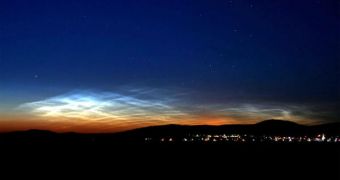In a special experiment, the American space agency launched Saturday night an unusual rocket into the atmosphere, with the express purpose of creating noctilucent (Latin for 'to shine at night') clouds. The result was an eerie cloud that shone in the night sky for a brief period of time, causing worried citizens to phone in and report bright lights and UFOs. These clouds are not rare, and they do occur naturally, experts say, but only at very high altitudes, about 50 miles (80 kilometers) above the ground.
The new mission launched from NASA's Wallops Flight Facility, on Wallops Island, Virginia, at 7:46 pm EDT (2346 GMT) on Saturday night, September 19th. “It was very impressive, albeit short-lived,” New York Hayden Planetarium instructor and guest lecturer Joe Rao, who witnessed the event directly, said of the artificially formed clouds. The Associated Press reported that people all the way from Boston called in and reported the brief glow in the night sky that the new rocket caused.
The new launch was overseen by the US Naval Research Laboratory (NRL) and the Department of Defense (DOD) Space Test Program, and was entitled the Charged Aerosol Release Experiment. A four-stage, NASA Black Brant XII suborbital sounding rocket was used for generating the cloud, which was created by spewing exhaust particles some 173 miles (278 km) above the planet's surface. Ground-based cameras and radars were pointed at the atmospheric phenomenon, which was observed in great detail, mission controllers report. The STPSat-1, which usually observes naturally occurring noctilucent clouds, was used to record data of the artificial phenomenon, as was the NASA AIM satellite, Space reports.
“We weren't exactly sure what we were going to see, as this was the very first time that a noctilucent cloud experiment was attempted. Would it be something obvious to the eye, or something rather faint? The 'head' of the comet [the rocket's fourth stage] rapidly faded out and the 'tail' gradually faded over the next minute or so into the background of the sky. I'm sure many unsuspecting folks up and down the East Coast were surprised by this very unusual sight,” Rao added. Data from the new experiment will be used to study natural noctilucent clouds, as well as the effects of rocket engines on the upper atmosphere.

 14 DAY TRIAL //
14 DAY TRIAL //